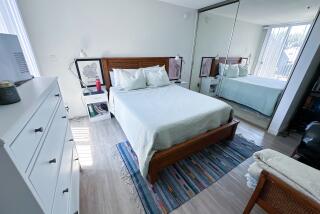Concrete’s got competition
- Share via
THE bare concrete floor -- once something of a novelty -- has become all but standard in modern homes these days, and with good reason. It doesn’t consume the natural resources of hardwood, and it doesn’t come with some of the environmental concerns related to carpeting. Jennifer Siegal, principal of Venice-based Office of Mobile Design, also points out that concrete can blend indoors and outdoors seamlessly, clean up easily and allow for radiant heat. However . . .
Some folks simply can’t live with the inevitable cracks that appear over time. Others have grown tired of the look. And then there is the health concern. “It’s hard on your back,” Siegal says, adding that cork and other materials are more forgiving yet still yield a clean, modern look. Expando is a rubber-cork mix that comes in cool colors, she says. She also likes bamboo and Durapalm, which is a darker and denser plywood made from coconut palms.
“People are definitely moving away from concrete because it is a high-maintenance product from start to finish,” interior designer Mark Brunetz says. “People still love the look; it’s just that good installations are typically more expensive. Because of tremors in SoCal, hairline fractures are unavoidable.”
One of Angela Adams’ newest lines of tile is called Concrete and comes in nine shades, including “dusk,” which could pass for poured concrete if it were not for the grout lines. That’s part of the appeal: A floor laid with Concrete looks like plain ol’ concrete -- spare, clean and monochrome, except the floor has an eye-appealing geometric pattern across its surface. The tiles, sold through Ann Sacks, are 16 inches square and cost about $23 each. (Go to www.annsacks.com/home.html, look under “Browse Products,” click on “Tile,” then “Leather, Wood & Concrete.”)
Synthetic choices also are growing. Fusion Floors ( www.fusionfloors.com) can pour a rainbow of finishes, matte or glossy, that run from wall to wall. Most of the designs are polyurethane-based, and all are water- and UV-resistant, so they resist staining and fading, the company says.
Below is a sampling of other concrete alternatives, many of which call upon new technology or recycled materials to prove that change really is afoot.
--
LISA BOONE AND CRAIG NAKANO
--
Epoxy: a bright canvas
THINK of it as icing on the cake. In the new Lofts at Hollywood and Vine, the design group Commune brightened a small space by topping the concrete floor with a glossy white epoxy finish. Now the floor acts as a bright canvas, allowing colors to pop and blending with the walls and kitchen cabinetry. The product used in the installation is called Westcoat ( www.westcoat.com), manufactured by a San Diego company called Life Deck. A Life Deck representative says the epoxy finishes crack less than bare concrete; scuffs can be waxed away. Residential projects generally run $5 to $15 a square foot, depending on the size of the job and the number of colors or effects in the design.
--
Pebblestone: warm, natural
WHEN developer James Wecker rebuilt a modern house off Mulholland Drive, he thought a concrete floor might seem a little tired. He went with Pebblestone ( www.pebblestone.net), a mix of natural rock and epoxy that is raked over the existing concrete, then troweled into its final fixed form. The pebbles bring a natural warmth to the minimalist interior, running from the living areas to patios that ring the house. Wecker, who first saw this type of flooring at art galleries in Paris, says it was surprisingly practical -- about $5.15 a square foot, including installation, he says. Workers were able to install 6,000 square feet of the material in just four days. It’s the same sort of look you’ll see in Design Within Reach showrooms and Pinkberry stores.
--
Resin: colorful and light
ANOTHER trend migrating from public to private spaces: translucent floors. Gem-colored, luminescent materials can resist staining and scratching better than before, thanks to advances in technology.
Fossil Faux Studios in San Francisco creates panels that can be used as flooring and stair treads, left, and on F1. The studio also designs hand-poured resin panels with embedded objects including corks, below, part of a new line featuring recycled material.
Marcia Stuermer, founder of Fossil Faux ( www.fossilfaux.com), says her resins are used mostly in art installations, conceptual furniture and architectural detailing, not flooring. “But there’s been a lot more interest in using the material that way,” she says. Each piece is custom artwork and priced accordingly, with small projects working out to about $150 per square foot.
--
Terrazzo: a new incarnation
TERRAZZO, that staple of office lobbies in the ‘50s and ‘60s, is back and bound for the home. It’s a logical alternative to plain concrete, given that most terrazzo is composed of stone or glass chips set in a cement-based mixture or liquid resin, then cured and polished. The material can be poured into place or precast into panels.
Architect Craig Steely used a custom mix by American Terrazzo Co. ( www.americanterrazzo.net) for interior and exterior areas of the house shown here.
Another supplier, Vertrazzo ( www.vertrazzo.com), uses 100% recycled glass. Its Chivalry Blue pattern gets its hue from ground-up Skyy vodka bottles; the Bistro Green terrazzo to the left contains bits of Perrier and Heineken glass, according to Scott Barrett, vice president of marketing.
Going green comes with a cost: Barrett says Vertrazzo starts at about $55 a square foot -- comparable to high-end granite, which may explain why it’s usually used as a countertop, not flooring.
Still, some of the designs are interesting alternatives to the slabs of exotic stone that also are increasingly popular in modern spaces.




